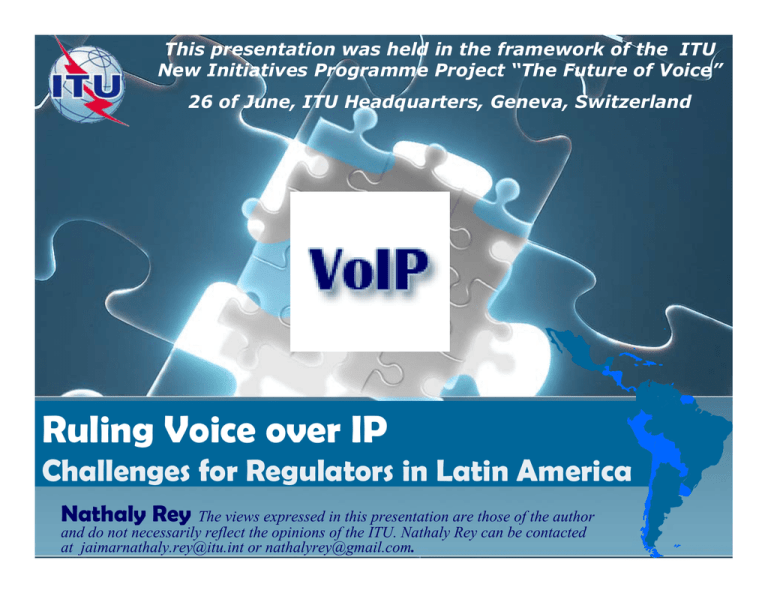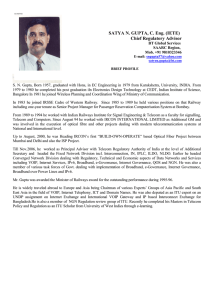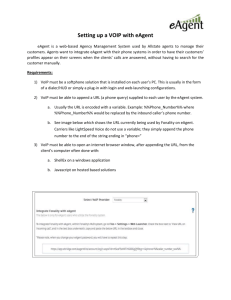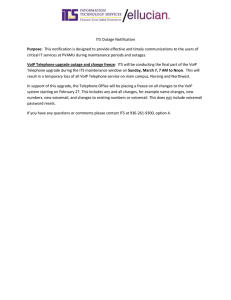This presentation was held in the framework of the ... New Initiatives Programme Project “The Future of Voice”
advertisement

This presentation was held in the framework of the ITU New Initiatives Programme Project “The Future of Voice” 26 of June, ITU Headquarters, Geneva, Switzerland Ruling Voice over IP Challenges for Regulators in Latin America Nathaly Rey The views expressed in this presentation are those of the author and do not necessarily reflect the opinions of the ITU. Nathaly Rey can be contacted at jaimarnathaly.rey@itu.int or nathalyrey@gmail.com. A Snapshot of VoIP in the Americas z z z z z z z z z z Liberalized Liberalized Approach: Approach: USA: USA: VoIP VoIP is is an an Internet Internet Application/Information Application/Information Service. Service. No No license license requirements, requirements, but but Universal Universal Service Service contribution. contribution. Canada Canada :PSTN :PSTN Interconnected Interconnected VoIP services VoIP services are are Telecommunications Telecommunications Services. Services. No No license requirements license requirements (registration) (registration) and and Universal Universal Service Service fund fund contribution. contribution. Argentina: Argentina: VoIP VoIP is is a a deregulated deregulated Telecommunication Telecommunication Service. Service. USF USF contribution. contribution. Licensing Licensing Restrictions Restrictions for for VoIP VoIP Mexico, Mexico, Venezuela, Venezuela, Colombia, Colombia, Chile, Brazil, Chile, Brazil, Peru, Peru, Dominican Dominican Republic Republic VoIP VoIP is is Illegal: Illegal: Bolivia, Bolivia, Honduras, Honduras, Guyana, Guyana, Paraguay, Paraguay, Costa Costa Rica. Rica. Legal? Illegal? Or just tolerated… Express z Legality Tacit Regulators state position z Illegality Regulatory framework specifically designed for VoIP (Definition, market entry, emergency calls, QoS etc) Although the regulatory framework has not been revised, its technology neutrality principles allow apply to VoIP based services. According level of competition VoIP services could be delivered for all / just licensed / only incumbent operator Express Legal restriction/ administrative disposition from regulator against VoIP Tacit Not possible. Would be in opposition to legal system and legality principle Not the case in Latin America but Chile is close Argentina Mexico Colombia Venezuela Peru Dominican R Costa Rica Bolivia Paraguay Some Skype rates examples Despite Despite prohibitions, prohibitions, VoIP VoIP is is available available in in the the whole whole region. region. The The regulatory regulatory approach approach taken taken can can be be reflected reflected in in the the rates. rates. Providers Providers like like Skype Skype are are playing playing aa growing growing role role in in LA. LA. Although Although Skype Skype is is not not licensed licensed to to operate operate in in many many countries, countries, consumers consumers in in those those nations nations can can freely freely download download their their software, software, use use their their services, services, and and will will likely likely not not face face any any government government sanction. sanction. Country US/ min Chile,USA, Canada, UK and 26 0.021 Argentina 0.032 Venezuela 0.052 *Brazil 0.054 Costa Rica 0.064 Peru 0.079 Dominican Republic 0.087 *Colombia 0.095 *Mexico 0.099 Panama 0.107 El Salvador/Uruguay 0.126 Bolivia 0.148 Paraguay 0.15 Guatemala 0.153 Ecuador 0.177 Nicaragua 0.216 Honduras 0.362 Cuba 1.025 Diference with basic tariff Rate ranking 1 0% 52% 2 147% 3 4 157% 204% 5 276% 6 314% 7 352% 8 371% 9 409% 10 500% 11 604% 12 614% 13 628% 14 15 742% 928% 16 1623% 17 4780% 18 VoIP Alowed Compet. Market VoIP BANNED STATE Monopoly The discussion… The main issues discussed at the regulatory level are: z z Legal Definition: Basic Service, Value Added Service, or new category. z z Market entry regime. z z Legal obligations of VoIP based services providers: Emergency calls, Universal Service contributions. z z VoIP based services offered by incumbents: Tariffs z z Numbering and Portability: Geographic restrictions for numbers? z z Interconnection Regime. z z Security and Privacy Some regulatory proceedings Country Cases: z Argentina z Brazil z Chile z Colombia z Mexico Mexico Brazil Colombia Chile Argentina Why Licensing is an Issue? z z z z In the developed world the main VoIPdiscussion issues are: Emergency Calls, QoS. Competition is strong and most of the Only Chile markets are mature. and In developing countries, the main issue in Uruguay have discussion is the market entry that is due to: reached UA goals z z Infrastructure needs to be deployed. Universal Access (UA) goals/ Impact of VoIP on Incumbent revenues/ investments. z z In some cases the problem is related with Case of existing licenses (cost/rights) Colombia who is close to reach UA ARGENTINA (8TH World, 2nd SA) FACTS Population: 39.3 m Capital: Buenos Aires Area: 2.8 million sq km Major language: Spanish GNI per capita: US $3,580 One of South America's largest economies rich in resources, and well-educated workforce. This country has successfully recovered worst ever economic crisis (2001). Its debt restructuring strategy has been a success. Mobile, fixed, and broadband. Penetration rates Broadband Broadband Growth Growth in in Argentina Argentina 1500000 1500000 26% 66% 44% 1000000 1000000 Broadband Broadband Dial Dial Up Up 500000 500000 00 22000033 22000044 22000055 Broadband subscribers grew 380% between 2003-2005. June 2006, represents 66% of residential connections In 2005 Broadband overtook Dial-Up April 2006, mobile reached penetration rate of 64% Fixed Fixed Penetration Penetration Growth Growth Mobile Mobile Penetration Penetration Growth Growth 6600 4400 57% 35% 21% 23% 60 60 40 40 2200 20 20 00 220003 03 22000044 20 200055 00 2002 2002 2003 2003 2004 2004 Remains in 23% since 2002 VoIP Adoption z z z z z z z z In March 2006 31% of the Argentinean companies have migrated to IP Telephony. In the residential sector VoIP providers are rapidly increasing their customers base. There is one big VoIP provider with own infrastructure: IPLAN. It was one of the first 100% IP telecom operator in Latin America. By the end of this year expect to have 50.000 residential users. Around 21 pure providers are based in this country. Regulatory Environment z z z z z z z z Telecommunications market was deregulated in 2000, all services were open to competition Telephony, Value Added, and Telecommunications Services concepts were merged in one: Telecommunications Services. Multiple licenses regime disappeared: Unique license to provide telecom services. Broadcasting was not touched by this provisions. No convergence framework. In March 2006 started the discussion. VoIP regulatory approach z z z z z z z z z z z z Current status : Legal (Tacit legality) Definition: Telecommunication Service (All VoIP forms) Market Entry: No legal barriers. Universal Service Fund Contributions: Yes, once the fund is created. Local loop unbundling: Mandatory for operators with Significant Market Power. No geographical restrictions for numbers. Telecom Sector 91% access market. Face strong competition in DLD and ILD but still remain dominants. Dominance in Broadband Market as well. Currently both are migrating their networks to IP based. Telecom is planning to launch Triple play by the end of this year. Cable Sector competition coming from Alternative last mile Infrastructure such as WLL started to be deployed by local operators Entrant TELMEX Started to migrate from PSTN to NGN network. Currently is trialing triple play 2 Cable operators are entering in Voice Market with triple play offers. Zarate (Buenos Aires) and SRL-CVC Córdoba) Electricity Sector INCUMBENTS Voice Market trends… Argentine electric power distributor Edenor is planning in telecom bussiness. BRAZIL z z .. FACTS Population: 182.8 million Capital: Brasilia Area: 8.55 million sq km Major language: Portuguese GNI per capita: US $3,000 Brazil is South America's largest country. It represents world's biggest democracies. Its development has been hampered by high inflation and foreign debt. Economic reforms in the 1990s brought some stability to the country's finances, the changes included privatizations and the opening up of its markets. VoIP regulatory approach z z z z z z z z z z z z Current status : Legal. Definition: PC to PC VoIP is a technology. Market Entry: z z Multimedia communication services license (SCM) Makes possible offers of capacity of transmission, emission and reception of information multimedia, on private networks Owners of this license can not exclusively give voice service. z z Public switched fixed telephony license (STFC) allows initiate and terminate calls outside of a private network. Local loop unbundling: Established in 2003 for voice, data, and video services. Universal Service Contribution: Public switched fixed telephony operators. No geographical restrictions for numbers: Virtual numbers are freely provided. TELEMAR BRASIL TELECOM TELEFONICA EMBRATEL Three incumbents in acces local market dominating market share (93.6%). However, competition is increasing in the domestic and international longdistance were the incumbet is Embratel. Facing competition from Entering in VoIP business Brasil Telecom : January 2006. Telefónica: February 2006 through its ISP, Terra. Telemar : March 2006 Cable Sector INCUMBENTS Voice Market trends TVA was the first triple player operator in Brazil. It offers cable telephony services in Rio de Janeiro and São Paulo under the brand name Ajato Voz. It has a partnership with Net2Phone and has been offering VoIP services since September 2004 for corporate customers and in May 2005 for residential customers. Net Servicos, the biggest tv cable company in Brazil launched its triple play strategy on March 2006, the VoIP service “Net Fone” is offered jointly with its controller Embratel. Net has 1,6mil customers for TV services and 451,100 for broadband services, a good base to build upon triple play. VoIP providers z z z z z z Brazil is one of the top five countries in the world communicating through Skype Brazil is likely to have the highest real number of VoIP users: z z Large number of companies pushing VoIP z z High number of Internet users (Latin America's largest). Leading local players include Transit Telecom, GVT, Hip Telecom, T mais and Primeira Escolha. There is also two important “pure” VoIP providers: z z The brazilian Vono wich has about to 150,000 VoIP customers. z z The giant Skype that plays a key role.Recently it has partnered with Transit Telecom to use Transit Telecom's license to offer fixedline numbers to its VoIP customers through its SkypeIn service. By using Transit Telecom's license, Skype will comply with Brazilian telecoms regulation, which requires all fixed-line operators to have a license in order to provide fixed-line services. Fixed-Mobile Convergence arrived z z Brasil Telecom (fixed operator) is to launch FixedMobile Convergence (FMC) services in 2006. The first such service will be delivered via Motorola's V3 GSM handset. This Wi-Fi-enabled mobile phone will be bundled with Brasil Telecom's broadband and VoIP services. z z Significance: Brasil Telecom is a start-up mobile operator in a fiercely competitive mobile market, and is likely to provide a wider range of FMC handsets as they arrive on the market. CHILE FACTS Population: 16.3 million Capital: Santiago Area: 756,096 sq km Major language: Spanish GNI per capita: US$5,220 zThe telecom market is further developed. This country plays a leading position in the region with the highest mobile and Internet penetration rates. It seems to be the undisputed ICT leader in the region. It appears in 12 e-indices, ranking first in the region seven times and never appearing lower than fourth. Policy and business environment related factors help it rank high Seems like the most stable and prosperous nations in South America . This country is characterized by its fairly regulatory environment and strong policies regarding of foreign investment. Chile Telecom sector has a direct contribution to GDP of 3.2. (2003). It was the first developing country in the world in privatizing the state owned Telecommunications Company in 1990. Broadband Market Incumbent Telefonica and VTR both are dominants in the Broadband market and accordingly are obligated to sell capacity in wholesale regime to retailers Broadband Broadband access access technologies technologies ADSL ADSL Cable Cable Modem Modem 5% 5% WLL WLL and and othe others rs 40% 40% 55% 55% Broadband Market Share Broadband Broadband vs vs Narrowband Narrowband 70% 70% 60% 60% 50% 50% 40% 40% 30% 30% 20% 20% 10% 10% 0% 0% 10% 10% 44% 44% 46% 46% Te Tele lefonica fonica VTR VTRMe Metropolis tropolis Jun Jun 2004 2004 Jun Jun 2005 2005 Broadband Broadband Narrow Narrowband band Ente Entell Regulatory Environment z z Telecommunication policy is being rethought and important changes has been announced in chilean telecommunications regulatory framework. z z Licensing regime will be modified: Licenses for provision of individual services will be replaced for a convergent license. The administrative procedures will be simplified as well. z z In 2004 the Subsecretaría de Telecommunications launched a public consultation regarding VoIP, the project has not been approved. The SUBTEL Proposition Service Accces Infraestructure to Service Qualifying Title VoIP- Public Telephonic Service (IP) Public Voice Telecommunication Service over Broadband IP enabled network (No Internet) Public Telephony Service Concesion. Same that provided for Trditional voice services and given by local areas. Broadband Internet Voice Telecommunication Service over Broadband Concesion. Povided National Numbering Geographic/Local National/Nomandic Interconection PSTN in the local areas were the consecion is given PSTN in all Local areas and whith other VoIP Services Same obligations for PSTN operators QoS Univesal Access * Responsabity shared with Internet Access Service Providers Not apply, because of the chilean Fund System After the public consultation z z Currently the procedure is stopped: z Antitrust Chilean Tribunal will decide the Future of VoIP in Chile. z Redvoiss case: Incumbent Telefonica de Chile accused of illegal contractual restrictions to ISP’s, and unfair blocking ports practice. SUBTEL is waiting for the decision to regulate VoIP. z z Incumbent (as in other countries) is refocusing its activity on alternative revenue streams. driving cost out of their voice businesses COLOMBIA FACTS Population: 45.6 million Capital: Bogota Area: 1.14 million sq km Major language: Spanish GNI per capita: US $2,020 The fourth largest country in South America and one of the continent's most populous nations. The signing of the Free Trade Agreement (FTA) between Colombia and the USA impacted on Colombia's telecom sector, promoting market liberalization and privatization. Penetration Rates Fixed and Mobile Penetration Rates Cable Modem is the dominant Broadband access technology 60% 50% 50% 40% 30% 17% 20% Narrowband still predominates 10% 0% Fixed Mobile 45% Narrowband Broadband 55% VoIP regulatory approach z z z Recently the CRT clarified that only licensed operators may offer PC to phone or phone to phone VoIP calls. In light of this only Orbitel, Telecom and Empresa de Telecomunicaciones de Bogotá (ETB), are the three operators, able to sell long distance services to Colombian customers. Probably,the restriction will end in 2007 when Colombia pretend to liberalizate long distance market. MEXICO FACTS Population: 106.4 million Capital: Mexico City Area: 1.96 million sq km Major language: Spanish GNI per capita: US $6,790 Mexico is a major oil producer and exporter. Nearly one-third of government revenue comes from the industry Regulatory Environment z z Liberalization Liberalization 1995 1995 Telecommunications Telecommunications Law Law opened opened every every telecoms telecoms service service up up to to competition. competition. z z Telephony Telephony services services in in its its different different modalities modalities -- local, local, domestic, domestic, long long distance distance international international only only can can be be delivered delivered for for licensed licensed operators operators .. Accordingly, Accordingly, any any other other company company that that commercializes commercializes services services of of voice voice without without services services without without the the qualifying qualifying title, title, including including protocol protocol IP IP as as it it is is the the case case of of the the ISP ISP is is violating, violating, among among other other orderings, orderings, the the Federal Federal Law Law of of Telecommunications. Telecommunications. z z In In April April 2006 2006 COFETEL COFETEL launched launched a a Public Public consultation consultation regarding regarding Triple Triple play play offers offers ““ The The convergence convergence project” project” Regulatory changes would have an important impact Regulatory changes would have an important impact on on the the direction direction of of the the market. market. Right Right now, now, players players must must have have licenses licenses to to provide provide specific specific services, services, regardless regardless of of the the platform platform on on which which these these are are delivered. delivered. This This situation situation prevents prevents incumbent incumbent Telmex Telmex from from introducing introducing video-overvideo-overDSL DSL solutions solutions and and requires requires cable cable companies companies to to engage engage in in alliances alliances with with CLECs CLECs in in order order to to offer offer VoIP VoIP solutions. solutions. z VoIP Regulatory Approach z z z z z z z z z z z z Current status : Legal Definition: Telecommunication Service Market Entry: For PSTN Interconnected service a license for public telephony is required. COFETEL considers VoIP providers to be voice telephony providers without distinction from traditional long distance or local service providers. VoIP providers have the same licensing requirements and contributions to universal service funds as any other voice (local or long distance) carrier. Universal Service Fund Contributions: Yes Geographic restrictions for numbers Local loop unbundling: Mexico has yet to pass LLU legislation. VoIP Market z z z z z z VoIP has gained huge popularity in Mexico, specially with small and medium sized businesses. Several companies offer VoIP services, although providers have the same licensing requirements as other voice carriers. Pure VoiP providers mainly settled in US are offering their residential solutions in the market. This has been pushing local operators to offer these services as well .The leading provider is VoxIP, which uses Telmex broadband lines. Telmex has been acused of cutting bandwidth to clients that use VoxIP and there's actually a legal battle between them. Other key VoIP providers include Avantel, Alestra and Maxcom. Skype is strong as well. Mexico is a heavy VoIP user (long distance prices of Telmex end up + high population migration are influent factors) TRENDS: Where is the Market going Sector Leading Players No national licenses for cable. Maket fragmented, triple play appears fragmented as well Triple Play Services In average prices for triple play are 30%-40% below Telecom Merging with telecom Telmex Axtel Avantel Maxcom Alestra (AT&T) Telmex (94% of landlines, and more than half of the internet market) is currently offering double play services. Other 2 Axtel and Maxcom have made partnerships with cable companies and also has announced Triple play offers, while Alestra, would be looking for a cable partner to launch its 3-play. Megacable In June 2006 has launched a new triple play service in partnership with telco Bestphone. The first has a presence in 12 states with over 700,000 subscribers for its TV services and 250,000 for internet. The second has the second largest fiber optic network in Mexico and is present in 30 cities. Megacable already provides cable services for a triple play package offered by t Maxco. Cablevision Cablevisión, a unit of Televisa, is finalizing an alliance with a telephone operator to provide telephony services as a carrier-ofcarriers by the end of the year Hi Plans to launch operations as a triple play provider by end of the year Cable Highlights Partnerships z z Investment Investment didn’t didn’t stop stop because because of of the the regulation regulation delays. delays. Around Around 600 cable companies, as well as incumbent Telmex have upgraded 600 cable companies, as well as incumbent Telmex have upgraded their their networks networks to to offer offer telephony telephony and and television television services services in in anticipation anticipation of of the the government's government's approval. approval. Investments Investments in in network network modernization modernization across across services services are are enabling enabling operators operators to to offer offer services services beyond beyond their their traditional traditional areas areas of of operation. operation. z z Meanwhile Meanwhile through through alliances alliances with with CLECS, CLECS, cable cable companies companies in in Mexico began to compete with a bundled offer, including voice Mexico began to compete with a bundled offer, including voice services. services. Telecom Telecom operators operators started started to to do do the the same same through through cablecos. cablecos. z z The The new new regulations regulations prohibit prohibit telcos telcos from from entering entering areas areas where where cable services are not yet available for a period of two years, cable services are not yet available for a period of two years, which which essentially gives existing cable companies a huge head start. essentially gives existing cable companies a huge head start. In In the the other other hand, hand, cable cable players players have have less less infrastructure infrastructure adjustments adjustments to to make make to to their their networks networks than than telecom telecom operators operators since since they they already already are are offering offering internet internet and and data data services, services, and and introducing introducing packages packages of of voice voice and and data data is is therefore therefore not not a a problem. problem. THANK YOU!! z z z z jaimarnathaly.rey@itu.int jaimarnathaly.rey@itu.int nathalyrey@gmail.com. nathalyrey@gmail.com.






